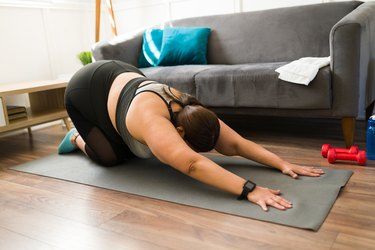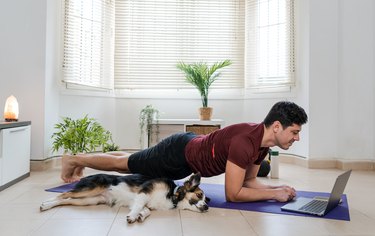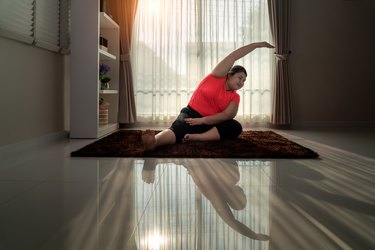
About 84 percent of adults have experienced back pain before, and a staggering 23 percent live with chronic lower back pain that affects their daily lives, per a February 2023 StatPearls report. If you fall into either of these camps, consider swapping the bottle of ibuprofen for your yoga mat instead.
So, does yoga help with back pain? "Practicing yoga can help prevent, relieve and sometimes even cure back pain," says Elma Panagaki, RYT-500, a certified Ashtanga yoga teacher at Bay Club in El Segundo, California.
Video of the Day
Ahead, Panagaki demonstrates the best yoga poses for back pain you can do at home for lasting relief — plus their benefits and how often to do them.
The Benefits of Yoga for Back Pain
Back pain often stems from a weak core or tight hip muscles. "It's important to have a strong core and back, and good posture can take the pressure off your spine," Panagaki says. "Sometimes the pain comes from the tight muscles, like the hips, and we need to stretch and improve their flexibility."
Yoga can help strengthen your muscles, release tension and improve your posture and mobility, which can all help prevent and ease back pain.
Researchers found that doing yoga once a week for 12 weeks was just as effective at treating moderate to severe chronic lower back pain as physical therapy in a June 2017 study in the Annals of Internal Medicine.
"When there is pain in a part of the body that can affect the entire body and the mind, practicing yoga can help ease that pain [in part by] helping the whole body relax," Panagaki says.
Which Type of Yoga Is Best for Back Pain?
In general, yoga focuses on alignments, or how your body is positioned during yoga movements. Proper alignment can help improve your flexibility and strengthen your body, which can help prevent or relieve pain, Panagaki says.
For beginners or people recovering from injuries, Panagaki recommends Hatha yoga. This type of yoga "helps you learn the alignments and prepare the body by strengthening the muscles to be able to hold poses longer," she says. Hatha yoga is done at a gentle pace and focuses on breathing techniques, which can also help with your mind-body connection.
"Gentle stretching classes are also great if you need a slow, easy practice to relax the mind and stretch the body," Panagaki says.
Are There Yoga Poses You Should Avoid if You Have Back Pain?
When you're dealing with back pain, it's best to avoid poses that compress and twist your spine and put too much pressure on your discs. According to Panagaki, some of these poses that can cause pack pain include deep backbends, such as:
- Camel pose
- Wheel pose
- Bow pose
Instead of these deep backbends, Panagaki recommends trying bridge pose (below), which can help avoid overstretching and compressing your back when you have aches.
Other poses to avoid if you have back pain include:
- Upward-facing dog
- Twisted crescent lunge
- Spinal twists
- Shoulder stand
Upward-facing dog can cause tension in your lower back, which is why Panagaki recommends cobra pose (below) instead.
"Twisted crescent lunge and all the spinal twists are also not recommended for back pain because they bring too much pressure on the discs," she says. "Another pose that is best to avoid is the shoulder stand because it causes a lot of stress on the cervical spine [neck]."
The Best Yoga Poses for Back Pain
Here are the best yoga poses to help relieve back pain, according to Panagaki.
1. Bridge Pose (Setu Bandha Sarvangasana)
"Bridge pose strengthens the back and legs, helping to relieve back pain and headaches," Panagaki says.
- Lie on your back with your arms resting by your sides, knees bent and feet flat on the ground hip-width apart. Your feet should be close enough to your hips that if you reach one hand at a time toward each heel, you can just touch it with your fingertips.
- Relax your arms alongside your body. Think of your shoulders being "glued" to the floor to help keep your spine neutral.
- Press into your feet and arms and lift your pelvis up, keeping your thighs parallel to each other
- For lower back pain, tuck your tailbone under.
2. Cat-Cow Pose (Bitilasana Marjaryasana)
"Cat-cow pose improves posture and balance, increases flexibility of the spine and releases the tension from the back and the neck," Panagaki says.
- Start from a tabletop position on your hands and knees with your wrists under your shoulders and your knees under your hips.
- Take a deep breath, open your chest, flex your spine by dropping your belly toward the floor and look up (cow pose).
- Exhale, round your back, tuck your tailbone in and look toward your naval (cat pose).
- Start each movement at the bottom of your spine, with your head moving last.
3. Happy Baby Pose (Ananda Balasana)
Happy baby pose decompresses your lower back, realigns your spine and opens your inner thighs, hips and groin, according to Panagaki.
- Lie flat on your back.
- Bend your knees and bring them toward your belly.
- Grip the outsides of your feet and gently pull your knees down toward your armpits. If you can't reach your feet, try grabbing the outsides of your ankles, shins or backs of thighs.
- Try to keep your ankles directly above your knees, so your shins are perpendicular to the floor. You want to feel a mild, comfortable stretching sensation in your hips but not pain.
- If you’d like, you can gently rock from side to side.
4. Downward-Facing Dog (Adho Mukha Shvanasana)
Downward-facing dog relieves back pain and sciatica, lengthens your spine and improves strength, according to Panagaki.
- Start from a tabletop position on your hands and knees with your wrists under your shoulders and your knees under your hips.
- Curl your toes under and press through your hands and toes to lift your knees away from the mat or floor.
- Extend your arms while lifting your hips up and back. Your body should form an inverted “V.”
- Let your head relax naturally toward the ground.
- Keep your knees soft to avoid shifting your weight too far forward.
- Distribute your weight as evenly as possible between your hands and feet.
- Prioritize finding length in your spine rather than pressing your heels to the floor or straightening your knees all the way.
5. Child's Pose (Balasana)
"Child's pose releases tension in the neck and back, stretches the spine, hips and thighs and relieves stress," Panagaki says.
- On your mat, begin by kneeling down with your hips approximately hip-width apart, feet untucked, and sit your hips back onto your heels.
- Inhale and elongate your spine.
- As you exhale, fold over your knees and rest your forehead on the mat.
- Stretch your arms forward with your palms facing down and gently press your hips back and down onto your feet to stretch your lower back and outer hips.
- If this feels restrictive, try widening your knees further apart until you feel more comfortable. Alternatively, you can bring your knees closer together, or all the way together, if that position suits you better. A good rule of thumb is to listen to your body and do what feels right!
6. Reclined Pigeon Pose (Supta Kapotasana)
"Reclined pigeon pose opens up the hips, releases tension from the lower back and increases flexibility of the hamstrings," Panagaki says.
- Lie on your back with your knees bent and feet planted firmly on the floor. Bring your heels close to your butt.
- Keeping your knees bent, place your right ankle onto your left knee, opening your right knee out to the side.
- On an inhale, use your right hand to press your right knee away from you. You should start feeling the stretch in your glute area. Press your lower back into the floor to keep your spine long.
- On an exhale, lift your left foot to bring the “figure four” in toward your upper body.
- Grab hold of the back of your left thigh with both hands to deepen the stretch. Don’t let your shoulders lift off the ground.
- Take 5 to 10 deep breaths into your rib cage, relaxing your pelvic muscles on each exhale.
- Release your hands and lower your left foot back to the ground, then lower your right foot back down and repeat on the other side.
7. Locust Pose (Salabhasana)
Locust pose strengthens your back, arms and legs, which can help prevent back pain, according to Panagaki.
- Lie face down on the floor with your arms resting by your sides and the palms of your hands facing downward.
- Turn your legs in toward each other to ensure your knees point directly toward the floor.
- Squeeze your glutes and inhale as you lift your head, chest, arms and legs off the floor.
- Extend your arms and legs behind you, arms parallel to the floor.
- Keep your head in a neutral position as you lift up as high as possible while your pelvis and lower abdominals stabilize your body on your mat.
8. Cobra Pose (Bhujangasana)
"Cobra pose strengthens the spine and gently stretches the chest and abdomen," Panagaki says.
- Lie face down with your legs extended behind you, feet hip-width apart (or slightly wider if your back is sensitive).
- Bring your hands back so that your thumbs are in line with your rib cage.
- Hug your elbows close to the sides of your body and press the tops of your feet down; your knees might lift away from the ground.
- Exhale to engage your abdominal muscles (think: low belly in and up) and lift your chest. Anchor your hips, pubic bone and the tops of your feet into the ground to support the lift.
- Press into your hands gently and engage them toward your body to help encourage your chest forward and your shoulders back.
- Lift and lengthen through the back of your neck and keep your gaze down and out. Keep your neck neutral.
- Breathe here for 3 to 5 breaths or 15 to 30 seconds.
9. Ragdoll Pose (Baddha Hasta Uttanasana)
"Ragdoll pose helps to alleviate lower back pain and stretches the back, neck, hamstrings and calves, and relaxes the mind and releases tension," Panagaki says.
- Start standing with your feet hip-width apart.
- Slightly bend your knees and fold forward as far as you can go.
- Cross your arms and hold your opposite elbows.
- Swing gently from side to side.
10. Knee-to-Chest Pose (Apanasana)
"Knee-to-chest pose improves flexibility of the back and spine, massages the abdominal organs and strengthens the back," Panagaki says.
- Lie on your back with your legs extended straight out in front of you and arms relaxed by your sides.
- Bend your left knee and bring it into your chest, holding your left shin or knee.
- Keep hold of your left shin or knee and rest here.
- Repeat on opposite leg.
How Often Should You Do Yoga if You Have Back Pain?
People saw significant improvements from doing yoga just once a week in the June 2017 Annals of Internal Medicine study. But if you can, "try to take a yoga class at least three times a week," Panagaki says.
For those days when you can't make it to the studio, Panagaki recommends stretching for 20 minutes. "Find a simple stretch routine with five or six easy yoga stretches and do it every day — even when you don't have back pain — to prevent the pain," she says. Stay in each stretch for at least 1 minute and try to relax through it.
Was this article helpful?
150 Characters Max
0/150
Thank you for sharing!
Thank you for your feedback!


